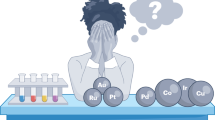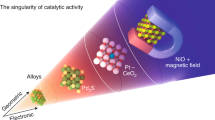Abstract
Orders in catalyst greater than one can be attributed to several different reaction mechanisms. Differentiating among these possibilities requires careful analysis of their rate laws, rational experiment design and accurate measurement of the progress of the reactions. We have compiled the most popular mechanisms proposed for reactions with an order in catalyst greater than one and derived their steady-state rate laws. We have analysed the rate laws and proposed experiments to discern between mechanisms. Finally, we have examined 100 case studies that showcase good practices to propose robust mechanisms and to avoid common pitfalls.

This is a preview of subscription content, access via your institution
Access options
Access Nature and 54 other Nature Portfolio journals
Get Nature+, our best-value online-access subscription
$29.99 / 30 days
cancel any time
Subscribe to this journal
Receive 12 digital issues and online access to articles
$119.00 per year
only $9.92 per issue
Buy this article
- Purchase on Springer Link
- Instant access to full article PDF
Prices may be subject to local taxes which are calculated during checkout







Similar content being viewed by others
Data availability
Fitting results are available in the Supplementary Information.
Change history
09 January 2023
In the version of this article initially published, the Supplementary information, “Fitting results” were missing and are now included in the online version of the article.
References
Adlington, N. K. et al. Process design and optimization in the pharmaceutical industry: a Suzuki–Miyaura procedure for the synthesis of savolitinib. J. Org. Chem. 84, 4735–4747 (2019).
Chamberlain, B. M. et al. Polymerization of lactide with zinc and magnesium β-diiminate complexes: stereocontrol and mechanism. J. Am. Chem. Soc. 123, 3229–3238 (2001).
Zhang, Y., Torker, S., Sigrist, M., Bregović, N. & Dydio, P. Binuclear Pd(I)–Pd(I) catalysis assisted by iodide ligands for selective hydroformylation of alkenes and alkynes. J. Am. Chem. Soc. 142, 18251–18265 (2020).
Wang, D., Izawa, Y. & Stahl, S. S. Pd-catalyzed aerobic oxidative coupling of arenes: evidence for transmetalation between two Pd(II)-aryl intermediates. J. Am. Chem. Soc. 136, 9914–9917 (2014).
Bartoszewicz, A., Miera, G. G., Marcos, R., Norrby, P.-O. & Martín-Matute, B. Mechanistic studies on the alkylation of amines with alcohols catalyzed by a bifunctional iridium complex. ACS Catal. 5, 3704–3716 (2015).
Dengler, J. E. et al. A one-component iron catalyst for cyclic propylene carbonate synthesis. Eur. J. Inorg. Chem. 2011, 336–343 (2011).
Han, H., Park, S. B., Kim, S. K. & Chang, S. Copper–nitrenoid formation and transfer in catalytic olefin aziridination utilizing chelating 2-pyridylsulfonyl moieties. J. Org. Chem. 73, 2862–2870 (2008).
Scott, S. L. The burden of disproof. ACS Catal. 9, 4706–4708 (2019).
Burés, J. What is the order of a reaction? Top. Catal. 60, 631–633 (2017).
Kalek, M. & Fu, G. C. Caution in the use of nonlinear effects as a mechanistic tool for catalytic enantioconvergent reactions: intrinsic negative nonlinear effects in the absence of higher-order species. J. Am. Chem. Soc. 139, 4225–4229 (2017).
Ali, C., Blackmond, D. G. & Burés, J. Kinetic rationalization of nonlinear effects in asymmetric catalytic cascade reactions under Curtin–Hammett conditions. ACS Catal. 12, 5776–5785 (2022).
Gesslbauer, S., Hutchinson, G., White, A. J. P., Burés, J. & Romain, C. Chirality-induced catalyst aggregation: insights into catalyst speciation and activity using chiral aluminum catalysts in cyclic ester ring-opening polymerization. ACS Catal. 11, 4084–4093 (2021).
Zielinski, T. J. & Alledoerfer, R. D. Least squares fitting of non-linear data in the undergraduate laboratory. J. Chem. Educ. 74, 1001–1007 (1997).
Perrin, C. L. Linear or nonlinear least-squares analysis of kinetic data? J. Chem. Educ. 94, 669–672 (2017).
Tellinghuisen, J. Least-squares analysis of data with uncertainty in y and x: algorithms in Excel and KaleidaGraph. J. Chem. Educ. 95, 970–977 (2018).
Nielsen, D.-T. C. & Burés, J. Visual kinetic analysis. Chem. Sci. 10, 348–353 (2019).
Silverstein, T. P. Nonlinear and linear regression applied to concentration versus time kinetic data from Pinhas’s sanitizer evaporation project. J. Chem. Educ. 88, 1589–1590 (2011).
Moore, D. A. & Cortés-Figueroa, J. E. Using a graphing calculator to determine a first-order rate constant. J. Chem. Educ. 79, 1462–1464 (2002).
Blackmond, D. G. Reaction progress kinetic analysis: a powerful methodology for mechanistic studies of complex catalytic reactions. Angew. Chem. Int. Ed. 44, 4302–4320 (2005).
Mathew, J. S. et al. Investigations of Pd-catalyzed ArX coupling reactions informed by reaction progress kinetic analysis. J. Org. Chem. 71, 4711–4722 (2006).
Burés, J. A simple graphical method to determine the order in catalyst. Angew. Chem. Int. Ed. 55, 2028–2031 (2016).
Burés, J. Variable time normalization analysis: general graphical elucidation of reaction orders from concentration profiles. Angew. Chem. Int. Ed. 55, 16084–16087 (2016).
Acknowledgements
We thank many colleagues for useful and inspiring discussions over the years, especially Prof. Donna Blackmond, Prof. Alan Armstrong, Prof. Igor Larrosa, Prof. Jason Hein and Dr. David Sale. We also thank all the authors of the case studies analysed in the Supplementary Information for the data reported. We acknowledge funding from the EPSRC projects EP/S005315/1, EP/R513131/1 and EP/T030666/1.
Author information
Authors and Affiliations
Contributions
J.B. conceived the Review and wrote the manuscript. C.A.-F. and G.H. analysed the data and wrote the Supplementary Information.
Corresponding author
Ethics declarations
Competing interests
The authors declare no competing interests.
Peer review
Peer review information
Nature Reviews Chemistry thanks D. Singleton and the other, anonymous, reviewer(s) for their contribution to the peer review of this work.
Additional information
Publisher’s note Springer Nature remains neutral with regard to jurisdictional claims in published maps and institutional affiliations.
Supplementary information
Rights and permissions
Springer Nature or its licensor (e.g. a society or other partner) holds exclusive rights to this article under a publishing agreement with the author(s) or other rightsholder(s); author self-archiving of the accepted manuscript version of this article is solely governed by the terms of such publishing agreement and applicable law.
About this article
Cite this article
Alamillo-Ferrer, C., Hutchinson, G. & Burés, J. Mechanistic interpretation of orders in catalyst greater than one. Nat Rev Chem 7, 26–34 (2023). https://doi.org/10.1038/s41570-022-00447-w
Accepted:
Published:
Issue Date:
DOI: https://doi.org/10.1038/s41570-022-00447-w



